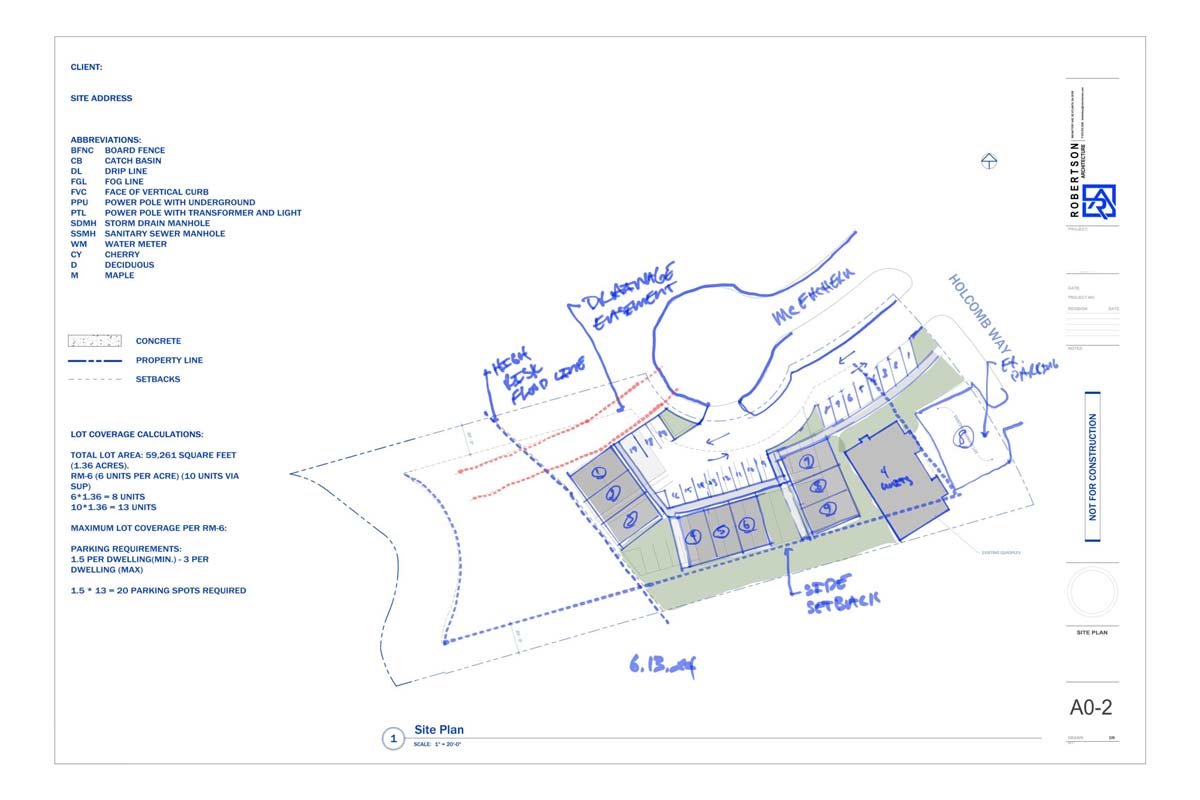
Land Development: Strategies for Maximizing Value and Returns
As a real estate developer or investor, you spend a lot of time searching for the perfect parcel of land for your development project. From raw land to reimagining the potential of a lot with an existing structure, there are ample options to choose from and you have to pick the best development plan for you.
Investing in land for your development is the first step in acquiring a tangible asset you will build upon with your investment property. By making sure the piece of land you are acquiring will support the type of structure you want to build, you can set your project up for success.
In this article, we’ll walk you through the land development process for residential developers and investors. At Robertson Architecture, we are often part of our clients’ site selection process and provide our expertise and analysis of the desired piece of land to be sure it will work in sync with your development program plans.
Choosing a Location
The first step in land development is understanding the location you want to invest in. Suppose you are looking to invest in a developed neighborhood. In that case, you’ll have to allocate more funds for the land acquisition, as you’re purchasing a property already established as a valuable asset. There is typically less supply than demand in this case. If you are investing in an area that still has many growth and investment opportunities, you may be able to acquire the land at a lower price.
Fortunately, there are multiple ways to enter the market. If you’re just starting as a developer, you may want to focus your efforts on an area that is up-and-coming and at the beginning of its growth. Once you have a few projects under your belt, you can work toward investing and building in already-developed neighborhoods that require a higher financial investment in the land costs alone.
Whether you’re investing in an up-and-coming or established area you need to run a market analysis during the project’s feasibility study to be sure it’s a sound investment for the price you’re considering. You want to run the numbers on comparable properties in the area to see what they are selling or renting for based on your future plans for the project. You also need to look at how fast other single-family, townhome, or multi-family developments that match your program are selling, vacancy rates for rentals, and if there is a need and desire for the type of property you want to build in the area. This market research is part of the vetting process for starting a new real estate development project and will help you maximize your returns on the property.
Hire an Architect to Join Your Development Team
Once you’ve settled on a desired location for your property, you want to look at the available land in the area to see what will best suit your project. This step is when it is a good idea to hire an architect, as they can examine the land with you to make sure the site supports the development you want to build. At this stage, it’s also important to understand how you’ll finance the project so you know how much you can allocate to land acquisition. You want to make sure the money you spend on the land will still allow you to build the development you envision, so it’s crucial not to overspend.
In an ideal world, you’d find the most incredible plot of land for a great price that perfectly fits your development vision. Unfortunately, that’s not always the case, and compromises will likely be necessary throughout your development journey. Be open-minded during this stage of the process to allow your creativity to expand with the possibilities of the available land.
Understanding Additional Land Development Costs
Land development costs include many items that might not initially seem intuitive. for surveys, utility installation, tree and shrub removal, structure removal if an existing structure is on the site, soil tests, permits, environmental impact studies, grading and clearing the land, and any other tests that need to be run to understand the property fully.
Pros and Cons to Look for in Land Acquisition
Part of the site analysis is also understanding the land’s value. Some elements lower land’s value, and others raise it. You want to be aware of proximity to airports, power plants, train tracks, landfills, flood plains, fault lines, cemeteries, septic, and toxic waste. You also want to understand the lot’s accessibility to clean water and other utilities which will incur additional costs if the lot isn’t already equipped with these items. Nearby amenities that make a piece of land more attractive to buyers and renters include proximity to parks, local businesses, and excellent schools.
These are critical elements to consider in order to maximize the value and returns on your land acquisition. There are different ways to approach land investment based on your budget, but the most important thing is doing the research ahead of time to be sure you are making a sound investment from the start. This is made easier with an architect and civil engineer as part of your development team from the early stages of the process.
Site Assessment
Using the discussions established with your architect in the pre-design phase of the architectural design process, you and your design team will look for a piece of land that will support your development based on local zoning laws, building codes, and the topography of the site. This step is where you can examine the potential for development to see what’s possible on the site.
Site assessment is a vital step in land development. You can’t just buy a parcel of land and put whatever you want on it without special exceptions, for example, rezoning. Cities have zoning laws that specify what building types are allowed and where. Just because you want to build a townhome community on the perfect 3-acre plot doesn’t mean the city and neighbors will welcome you with open arms.
Additionally, you need to This knowledge is typically discovered during the site selection phase via the test fit, due diligence, and zoning research process. If you find the perfect piece of land, but the current zoning won’t allow it by right, then rezoning is another avenue that can be explored.
Your architect should be skilled and experienced at researching these details for you. Being an architect isn’t just dreaming up development designs. It’s a balance of creating within the restraints of what the land allows and the client’s goals for the project.
At this stage, your architect will make sure the plans fall within the zoning laws for the site. They will also look at the site’s topography, drainage, size, and more to be sure that your development program is possible on the site or if it’s best to look for a new site. You may also choose to modify the design to fit the site if the location is paramount to the development goal.
Let Us Help You Start the Land Development Process
Land development is a multi-step process that sets the tone for the rest of the project. While land acquisition seems like a simple decision, many factors contribute to making a wise financial investment when choosing the right piece of land for your development.
If you follow these guidelines for land development, you’re setting your project up for success before construction even begins. At Robertson Architecture, we walk our clients through every step of the development and architectural design process and strive to be a resource our clients can lean on during the technical and tactical research that’s part of land acquisition. Reach out today to learn more about how we can support your land development needs!
Author: David Robertson is an Atlanta based architect and founder of Robertson Architecture. Robertson Architecture on the premise of helping entrepreneurs and like-minded individuals exceed their goals.
In 2018, Robertson Architecture was formed with the single focus of helping homeowners and entrepreneurs exceed their goals. The firm works with custom residential homes, townhouses, restaurants, and hotels all across the Southeast. David has a passion for helping entrepreneurs and homeowners realize their dreams.
With over 10 years of experience, David spent the beginning part of his career working on small to medium sized commercial projects across the U.S., including hospitality projects, office buildings, multi-family, and custom homes.
- David Robertson AIA NCARB
- Office 470.795.9596
- info@robertsonarc.com

0 comments